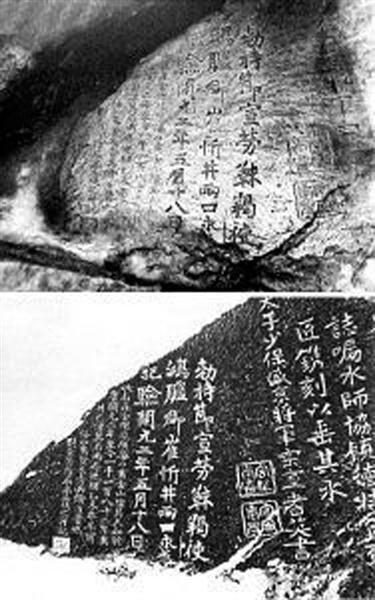China Group Demands Return of 1,300 Relic Looted by Japanese Soldiers in 1908
| Andy Vitalicio | | Aug 12, 2014 08:23 PM EDT |
Images of the Honglujing Stele, a 1,300-year-old tablet that tells about China's endorsement of the first king of the Bohai Kingdom in 713 A.D. The relic is said to be housed in the Japanese Imperial Palace in Tokyo.
A Chinese group has found another way to assert that Japan has a lot to answer for when it occupied China for 50 years, and should not forget about that when current issues about territorial disputes come into play.
Writing to the present Emperor of Japan, a Chinese group has asked Japan to return a 1,300-year-old stone stele believed looted by Japanese soldiers from northeastern China, somewhere between 1906 and 1908. The relic is called the Honglujing Stele and is believed to be sitting in virtual seclusion in the Japanese imperial palace after the Japanese army shipped the stele to Japan in 1908 as a wartime "trophy."
Like Us on Facebook
Xinhua reports that the China Federation of Demanding Compensation from Japan (CFDC) delivered the letter on Sunday via the Japanese Embassy in China, demanding that Japanese Emperor Akihito and the Japanese government return the Honglujing Stele, a piece of tablet which documents China's endorsement of the first king of the Bohai Kingdom (698-926) in 713 A.D.
The letter said the stele should be handed back to China as soon as possible.
CFDC president Tong Zeng said the federation has not yet received any reply from Japanese authorities, Xinhua reported.
The Honglujing Stele measures three meters wide, 1.8 meters tall and two meters thick, and contains 29 ancient Chinese characters showing that the first king of the Bohai Kingdom was conferred the title by an emperor of China's Tang Dynasty (618-907).
The stele was originally placed in Lushun in northeast China's Liaoning Province, but was believed to have been confiscated by Japanese invaders and shipped to Japan.
Wang Jinsi, a CFDC director in charge of recovering cultural relics, said the Honglujing Stele is one of the most important relics taken from China to Japan in last century.
Earlier records say Japanese soldiers took some 3.6 million relics from China, and ransacked about 740 relic sites during the five decades between the first Sino-Japanese War in 1894 and Japan's World War II defeat in 1945.
"These historic relics, which belong to China but now lie in Japan, have done great damage to Sino-Japanese ties," said Wang. "They should be returned to their rightful owner."
The CFDC plans to send an expert team to Japan to further pressure Japanese authorities to return the stele. If that doesn't work, the group may have to pressure the Chinese government to step in.
In 2005, Japan handed over an 18th-century Korean stele, the Bukgwandaecheopbi (meaning "monument for the great victory at Bukgwan"), which commemorates Korean military victories against the invading army of Japan in the 1590s, after repeated requests by official authorities and civic groups.
CFDC president Tong Zeng said Chinese experts have been gathering evidence of Japan's looting of the Honglujing Stele and its current location in order to make way for its return.
What we try to recover is not just the relic itself, but also a symbol of international justice," he said.
©2015 Chinatopix All rights reserved. Do not reproduce without permission
EDITOR'S PICKS
-

Did the Trump administration just announce plans for a trade war with ‘hostile’ China and Russia?
-

US Senate passes Taiwan travel bill slammed by China
-

As Yan Sihong’s family grieves, here are other Chinese students who went missing abroad. Some have never been found
-

Beijing blasts Western critics who ‘smear China’ with the term sharp power
-

China Envoy Seeks to Defuse Tensions With U.S. as a Trade War Brews
-

Singapore's Deputy PM Provides Bitcoin Vote of Confidence Amid China's Blanket Bans
-

China warns investors over risks in overseas virtual currency trading
-

Chinese government most trustworthy: survey
-

Kashima Antlers On Course For Back-To-Back Titles
MOST POPULAR
LATEST NEWS
Zhou Yongkang: China's Former Security Chief Sentenced to Life in Prison

China's former Chief of the Ministry of Public Security, Zhou Yongkang, has been given a life sentence after he was found guilty of abusing his office, bribery and deliberately ... Full Article
TRENDING STORY

China Pork Prices Expected to Stabilize As The Supplies Recover

Elephone P9000 Smartphone is now on Sale on Amazon India

There's a Big Chance Cliffhangers Won't Still Be Resolved When Grey's Anatomy Season 13 Returns

Supreme Court Ruled on Samsung vs Apple Dispute for Patent Infringement

Microsoft Surface Pro 5 Rumors and Release Date: What is the Latest?










